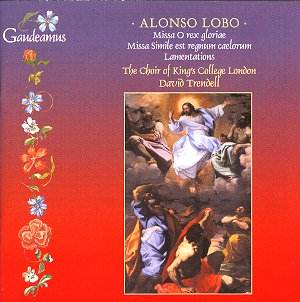Music of the Spanish renaissance has occupied a prominent
place in the early music revival over the last two decades or so. Alonso
Lobo has undoubtedly been one of the most significant discoveries in
that genre. That musical activity in the Iberian peninsula lay somewhat
outside the mainstream of European trends (if such things actually ever
existed) has made this repertoire of some appeal to performing groups.
Westminster Cathedral Choir has done much to re-establish
the reputation of Francesco Guerrero, and it was that master who was
the greatest influence on Alonso Lobo (1555-1617). The biographical
information about Lobo and his formative influences in the detailed
booklet notes by David Trendell place the composer in a context, although
he does go on into a rather over-detailed verbal description of his
favourite bits of the recorded works. There is much emphasis placed
upon the individuality of the music; how it is so different from the
likes of Palestrina and even of Lobo’s other great mentor - Victoria.
It is surprising then that this apparent difference
is the one thing that does not come across strongly in the recording.
Certainly, tempi are generally brisk and there is quite a sense of vigour,
but the overall sound is hardly very "Spanish". Indeed, the
greatest influence on the sound of the choir must be somewhat closer
to home in their great namesake college at Cambridge. King’s London
is a choir of undergraduates of course, sopranos not boys, and it must
be said that they would be at the forefront of such groups in England.
There is a great confidence in the singing, although it is not without
its moments of roughness as well, especially from some unfocussed basses
and occasionally strident tenors. The thing that concerns this listener
is that there appears to have been no thought given (certainly none
important enough to warrant a mention in the booklet notes) as to the
type of sound with which this music should be sung. It is undeniable
that Lobo’s music does have strongly individual aspects and is highly
charged and coloured. Does it seem sensible then that the soprano line
should be aiming for the bright purity of sound that we associate particularly
with King’s Cambridge under David Willcocks or that the general nature
of line and phrasing should be long and legato?
There is a further matter about the size of the choir.
Notwithstanding that college choirs have functions other than the recording
of music, and amongst the most important of those is to give students
the opportunity to sing etc, the group used for this disc consists of
9 sopranos, 6 altos (1 male, 5 female), 5 tenors and 7 basses; 27 in
all. It could be argued that the numbers are needed, as much of the
music, particularly the very impressive Lamentationes, is in
six parts. However, the very presence of thick textures in the music
suggests that a reduction in the number of voices would aid the individual
lines in balancing and heighten the variety inherent in the polyphonic
texture. It is this blending and balance that is lacking too often in
this recording. While there are many moments of great intensity and
passion, they are not adequately balanced by moments of searchingly
quiet singing or transparent textures. This is not a situation unique
to the choir of King’s London; indeed it is a too frequent feature of
many English groups, which have many of the best vocal resources in
Europe to draw on, but are too often unable to reach the heights of
colouration and variety that we hear in performances from, say, a Spanish
(or, indeed, Catalan) group such as La Capella Reial de Catalunya
under Jordi Savall. Of course, in many respects it is unfair to compare
a choir of talented undergraduates to one of seasoned professionals,
but the recording market does not draw such distinctions. Much of the
singing on this disc is really very fine, and the works are certainly
not widely available (the three motets, at the least, being first recordings)
so there is something to be said for adding this disc to a collection,
but as an example of Iberian renaissance Mass settings, the inexperience
of tenors and basses and the lack of variation of colour in the sopranos
leaves the performance coming across as somewhat less memorable than
the music deserves.
Peter Wells
FULL DETAILS
Missa Simile est Regnum Caelorum
1 Kyrie 2’25"
2 Gloria 4’44"
3 Regina Caeli 2’26"
4 Credo 7’32"
5 Sanctus and Benedictus 5’11"
6 Agnus Dei 4’57"
7 Lamentationes Ieremiae Prophetae 20’24"
Missa O Rex Gloriae
8 Kyrie 2’15"
9 Gloria 3’54"
10 Ecce Ascendimus Ierosolymam 2‘39""
11 Credo 6’26"
12 Sanctus and Benedictus 4’24"
13 Agnus Dei 4’18"
Ego Flos Campi 2’15"

